Calixarenes: Generalities and Their Role in Improving the Solubility, Biocompatibility, Stability, Bioavailability, Detection, and Transport of Biomolecules
Abstract
1. Introduction
2. Calix[n]arenes
2.1. Summary Description of Its Structure
2.2. Complexing Properties of Calixarenes
2.3. Amphiphilic Assemblies Based on Calixarenes
2.4. Types of Molecules that Can Be Recognized by Calixarenes and Their Effect
2.4.1. Recognition of Dopamine by Calixarenes
2.4.2. Improved Solubility of Testosterone with Calixarene
2.4.3. Biomaterial Modification with Calixarenes to Avoid Allergy or Infection
2.4.4. Combination of Calixarenes and Cyclodextrins to Improve the Solubility of an Anthelmintic Drug
2.4.5. Drug Delivery Systems Based on Calixarenes
2.4.6. Controlled Release of Doxorubicin by Vesicles Based on Calixarenes
3. Conclusions
Author Contributions
Funding
Acknowledgments
Conflicts of Interest
References
- Boraste, D.R.; Chakraborty, G.; Ray, A.K.; Shankarling, G.S.; Pal, H. Supramolecular host–guest interaction of antibiotic drug ciprofloxacin with cucurbit[7] macrocycle: Modulations in photophysical properties and enhanced photostability. J. Photochem. Photobiol. A 2018, 358, 26–37. [Google Scholar] [CrossRef]
- Harit, T.; Bellaouche, R.; Mokhtari, C.; El Bali, B.; Asehraou, A.; Malek, F. New generation of tetrapyrazolic macrocyclic: Synthesis and examinaton of their complexation properties and antibacterial activity. Tetrahedron 2017, 73, 5138–5143. [Google Scholar] [CrossRef]
- Syakaev, V.V.; Morozova, J.E.; Bogdanov, A.V.; Shalaeva, Y.V.; Ermakova, A.M.; Voloshina, A.D.; Zobov, V.V.; Nizameev, I.R.; Kadirov, M.K.; Morinov, V.F.; et al. Solubilization of azo-dye-modified isatin derivative by amphiphilic carboxyresorcinarenes: The effect of macrocycle structure on the supramolecular association. Colloids Surf. A. 2018, 553, 368–377. [Google Scholar] [CrossRef]
- Josic, D.; Reutter, W.; Reusch, J. Crown ethers as ligands for high-performance liquid chromatography of proteins and nucleic acids. J. Chromatogr. A 1989, 476, 309–318. [Google Scholar] [CrossRef]
- Azzi, J.; Jraij, A.; Auezova, L.; Fourmentin, S.; Greige-Gerges, H. Novel findings for quercetin encapsulation and preservation with cyclodextrins, liposomes, and drug-in-cyclodextrin-in-liposomes. Food Hydrocoll. 2018, 81, 328–340. [Google Scholar] [CrossRef]
- Li, X.; Zheng, B.D.; Peng, X.H.; Li, S.Z.; Ying, J.W.; Zhao, Y.; Huang, J.-D.; Yoon, J. Phthalocyanines as medicinal photosensitizers: Developments in the last five years. Coord. Chem. Rev. 2017, 379, 147–160. [Google Scholar] [CrossRef]
- Korchowiec, B.; Korchowiec, J.; Orlof-Naturalna, M.; Regnouf de Vains, J.-B.; Rogalska, E. Two antibacterial nalidixate calixarene derivatives in cholesterol monolayers: Molecular dynamics and physicochemical effects. Colloids Surf. B Biointerfaces 2016, 145, 777–784. [Google Scholar] [CrossRef] [PubMed]
- Yang, W.; de Villiers, M.M. Effect of 4-sulphonato-calix[n]arenes and cyclodextrins on the solubilization of niclosamide, a poorly water soluble anthelmintic. AAPS J. 2005, 7, E241–E248. [Google Scholar] [CrossRef] [PubMed]
- Da Silva, E.; Valmalle, C.; Becchi, M.; Cuilleron, C.Y.; Coleman, A.W. The use of electrospray mass spectrometry (ES/MS) for the differential detection of some steroids as calix-[n]-arene sulphonate complexes. J. Incl. Phenom. Macrocycl. 2003, 46, 65–69. [Google Scholar] [CrossRef]
- Liu, M.; Li, L.-S.; Da, S.-L.; Feng, Y.-Q. Preparation of p-tert-butyl-calix[8]arene bonded silica stationary phase and separation for steroid hormone medicines. Anal. Lett. 2004, 37, 3017–3031. [Google Scholar] [CrossRef]
- Dawn, A.; Chandra, H.; Ade-Browne, C.; Yadav, J.; Kumari, H. Multifaceted supramolecular interactions from C-methylresorcin[4]arene lead to an enhancement in in vitro antibacterial activity of gatifloxacin. Chem. Eur. J. 2017, 23, 18171–18179. [Google Scholar] [CrossRef] [PubMed]
- Rhlalou, T.; Ferhat, M.; Frouji, M.A.; Langevin, D.; Metayer, M.; Verchére, J.-F. Facilitated transport of sugars by a resorcinarene through a supported liquid membrane. J. Membr. Sci. 2000, 168, 63–73. [Google Scholar] [CrossRef]
- Tbeur, N.; Rhlalou, T.; Hlaibi, M.; Langevin, D.; Métayer, M.; Verchére, J.F. Molecular recognition of carbohydrates by a resorcinarene. Selective transport of alditols through a supported liquid membrane. Carbohydr. Res. 2000, 329, 409–422. [Google Scholar] [CrossRef]
- Coleman, A.; Perret, F.; Moussa, A.; Dupin, M.; Guo, Y.; Perron, H. Calix[n]arenes as protein sensors. In Creative Chemical Sensor Systems; Springer: Berlin/Heidelberg, Germany, 2007; Volume 277, pp. 31–88. [Google Scholar]
- Oshima, T.; Baba, Y. Recognition of exterior protein surfaces using artificial ligands based on calixarenes, crown ethers, and tetraphenylporphyrins. J. Incl. Phenom. Macrocycl. Chem. 2012, 73, 17–32. [Google Scholar] [CrossRef]
- Sanabria, E.; Maldonado, M. Host–guest recognition of toxicological interest molecules by calixarenes. Crit. Rev. Anal. Chem. 2019, in press. [Google Scholar] [CrossRef] [PubMed]
- Guo, D.-S.; Liu, Y. Supramolecular chemistry of p-sulfonatocalix[n]arenes and its biological applications. Acc. Chem. Res. 2014, 47, 1925–1934. [Google Scholar] [CrossRef] [PubMed]
- Hwang, K.M.; Qi, Y.M.; Liu, S.Y.; Choy, W. Treatment of Infection by Enveloped Virus with Calix(n)arene Compounds. U.S. Patent 5,441,983, 15 August 1995. [Google Scholar]
- Da Silva, E.; Ficheux, D.; Coleman, A.W. Anti-thrombotic activity of water-soluble calix[n]arenes. J. Incl. Phenom. Macrocycl. Chem. 2005, 52, 201–206. [Google Scholar] [CrossRef]
- Mourer, M.; Duval, R.E.; Finance, C.; Regnouf-de-Vains, J.-B. Functional organisation and gain of activity: The case of the antibacterial tetra-para-guanidinoethyl-calix[4]arene. Bioorg. Med. Chem. Lett. 2006, 16, 2960–2963. [Google Scholar] [CrossRef] [PubMed]
- Colston, M.J.; Hailes, H.C.; Stavropouloss, E.; Herve, A.C.; Herve, G.; Goodworth, K.J.; Hill, A.M.; Jenner, P.; Hart, P.D.; Tascon, R.E. Antimycobacterial calixarenes enhance innate defense mechanism in murine macrophages and induce control of mycobacterium tuberculosis intection in mice. Infect. Immun. 2004, 72, 6318–6323. [Google Scholar] [CrossRef] [PubMed][Green Version]
- Sun, J.Z.; Blaskovich, M.A.; Jain, R.K.; Delaure, F.; Paris, D.; Brem, S.; Wotoczek-Obadia, M.; Lin, Q.; Coppola, D.; Choi, K.H.; et al. Blocking angiogenesis and tumorigenesis with GFA-116, a synthetic molecule that inhibits binding of vascular endothelial growth factor to its receptor. Cancer Res. 2004, 64, 3586–3592. [Google Scholar] [CrossRef] [PubMed]
- Wenzel, T.J. Calixarenes and calix[4]resorcinarenes as chiral NMR solvating agents. J. Incl. Phenom. Macrocycl. Chem. 2014, 78, 1–14. [Google Scholar] [CrossRef]
- Sanabria, E.; Esteso, V.; Vargas, E.F.; Maldonado, M.V. Experimental comparative study of solvent effects on the structure of two sulfonated resorcinarenes. J. Mol. Liq. 2018, 254, 391–397. [Google Scholar] [CrossRef]
- Sanabria, E.; Esteso, M.A.; Pérez-redondo, A.; Vargas, E.; Maldonado, M. Synthesis and characterization of two sulfonated resorcinarenes: A new example of a linear array of sodium centers and macrocycles. Molecules 2015, 20, 9915–9928. [Google Scholar] [CrossRef] [PubMed]
- Casas-Hinestroza, J.L.; Maldonado, M. Conformational aspects of the O-acetylation of C-tetra(phenyl)calixpyrogallol[4]arene. Molecules 2018, 23, 1225. [Google Scholar] [CrossRef] [PubMed]
- Velásquez-Silva, V.; Cortés, B.; Rivera-Monroy, Z.J.; Pérez-redondo, A.; Maldonado, M. Crystal structure and dynamic NMR studies of octaacetyltetra(propyl)calix[4]resorcinarene. J. Mol. Struct. 2017, 1137, 380–386. [Google Scholar] [CrossRef]
- Tero, T.-R.; Nissinen, M. A perspective to resorcinarene crowns. Tetrahedron 2014, 70, 1111–1123. [Google Scholar] [CrossRef]
- Yang, F.; Guo, H.; Vicens, J. Mini-review: Calixarene liquid crystals. J. Incl. Phenom. Macrocycl. Chem. 2017, 80, 177–186. [Google Scholar] [CrossRef]
- Maldonado, M.; Sanabria, E.; Batanero, B.; Esteso, M.A. Apparent molal volume and viscosity values for a new synthesized diazoted resorcin[4]arene in DMSO at several temperatures. J. Mol. Liq. 2017, 231, 142–148. [Google Scholar] [CrossRef]
- Castillo-Aguirre, A.; Rivera-Monroy, Z.; Maldonado, M. Selective O-alkylation of the crown conformer of tetra(4-hydroxyphenyl)calix[4]resorcinarene to the corresponding tetraalkyl ether. Molecules 2017, 22, 1660. [Google Scholar] [CrossRef] [PubMed]
- Sanabria, E.; Maldonado, M.; Esteso, M.A.; Vargas, E.F. Volumetric and acoustic properties of two sodium sulfonateresorcin[4]arenes in water and dimethylsulfoxide. J. Mol. Liq. 2018, 249, 868–876. [Google Scholar] [CrossRef]
- Ortolon, A.O.; Oestrom, I.; Caramori, G.F.; Parreira, R.L.T.; Muñoz-Castro, A.; Bickelhaupt, F.M. Anion recognition by organometallic calixarenes: Analysis relativist DFT calculations. Organometallics 2018, 37, 2167–2176. [Google Scholar] [CrossRef]
- Fulton, D.A.; Stoddart, J.F. Neoglycoconjugates based on cyclodextrins and calixarenes. Bioconjug. Chem. 2001, 12, 655–672. [Google Scholar] [CrossRef] [PubMed]
- Gutsche, D. Calixarenes: A personal history. In Calixarenes in the Nanoworld; Vicens, J., Harrowfield, J., Eds.; Springer: Dordrecht, The Netherlands, 2007; pp. 1–19. [Google Scholar]
- Del Valle, E.M. Cyclodextrins and their uses: A review. Process Biochem. 2004, 39, 1033–1046. [Google Scholar] [CrossRef]
- Lamb, J.D.; Christensen, J.J.; Izatt, S.R.; Bedke, K.; Astin, M.S.; Izatt, R.M. Effects of salt concentration and anion on the rate of carrier-facilitated transport of metal cations through bulk liquid membranes containing crown ethers. J. Am. Chem. Soc. 1980, 102, 3399–3403. [Google Scholar] [CrossRef]
- Roundhill, D.M. Fundamentals: Ligans, complexes, synthesis, purification, and structure. In Comprenhensive Coordination Chemistry II.; Mc Cleverty, J., Meyer, T.J., Eds.; Elsevier: Amsterdam, The Netherlands, 2003; pp. 485–491. [Google Scholar]
- Shinkai, S.; Araki, K.; Manabe, O.J. Does the calixarene cavity recognise the size of guest molecules? On the hole-size selectivity in water-soluble calixarenes. Chem. Soc. Chem. Commun. 1988, 3, 187–189. [Google Scholar] [CrossRef]
- Ferreira, J.F.; Bagatin, I.A. A Cr(VI) selective probe based on a quinoline-amide calix[4]arene. Spectrochim. Acta A Mol. Biomol. Spectrosc. 2018, 189, 44–50. [Google Scholar] [CrossRef] [PubMed]
- Gautsche, C.D.; Alami, I. Calixarenes 23. The complexation and catalytic properties of water soluble calixarenes. Tetrahedron 1988, 44, 4689–4694. [Google Scholar] [CrossRef]
- Almi, A.; Arduini, A.; Casnati, A.; Pochini, A.; Unagaro, R. Chlomethylation of calixarenes and synthesis of new water soluble macrocyclic host. Tetrahedron 1989, 45, 2177–2182. [Google Scholar] [CrossRef]
- Van Loon, J.-D.; Arduini, A.; Coppi, L.; Verboom, W.; Pochini, A.; Ungaro, R.; Harkema, S.; Reinhoudt, D.N. Selective functionalization of calix[4]arenes at the upper rim. J. Org. Chem. 1990, 55, 5639–5646. [Google Scholar] [CrossRef]
- Makha, M.; Raston, C.L. Direct synthesis of calixarenes with extended arms: p-Phenylcalix[4,5,6,8]arenes and their water-soluble sulfonated derivatives. Tetrahedron Lett. 2001, 42, 6215–6217. [Google Scholar] [CrossRef]
- Mazzone, G.; Alberto, M.E.; Fortuna, P.; Nino, R.; Toscano, M. Anion–π weak interactions in a heteroaromatic calixarene receptor. A theoretical investigation. Inorg. Chim. Acta 2018, 470, 379–384. [Google Scholar] [CrossRef]
- Schadel, U.; Sansone, F.; Casnati, A.; Ungaro, R. Synthesis of upper rim calix[4]arene divalent glycoclusters via amide bond conjugation. Tetrahedron 2005, 61, 1149–1154. [Google Scholar] [CrossRef]
- Kazakova, E.K.; Ziganshina, A.U.; Muslinkina, L.A.; Morozova, J.E.; Makarova, N.A.; Mustafina, A.R.; Habicher, W.D. The complexation properties of the water-soluble tetrasulfonatomethylcalix[4]resorcinarene toward α-aminoacids. J. Incl. Phenom. Macrocycl. Chem. 2002, 43, 65–69. [Google Scholar] [CrossRef]
- Hu, W.-J.; Ma, M.-L.; Liu, Y.A.; Li, J.-S.; Jiang, B.; Wen, K. Synthesis and structures of malonate derivative-calix[4]arene conjugates. Chin. Chem. Lett. 2015, 26, 914–917. [Google Scholar] [CrossRef]
- Cardona, F.; Isoldi, G.; Sansone, F.; Casnati, A.; Goti, A.J. Building multivalent iminosugar-based ligands on calixarene cores via nitrone cycloadditions. Org. Chem. 2012, 77, 6980–6988. [Google Scholar] [CrossRef] [PubMed]
- Shalaeva, Y.V.; Marazova, J.E.; Syakaev, V.V.; Kazakova, E.K.; Ermakova, A.M.; Nizamecv, I.R.; Kadirov, M.K.; Konovalov, A.I. Supramolecular nanoscale systems based on amphiphilic tetramethylen sulfonatocalix[4]resorcinarenes and cationic polyelectrolyte with controlled guest molecule binding. Supramol. Chem. 2017, 29, 278–289. [Google Scholar] [CrossRef]
- Morales, A.; Santana, A.; Althoff, G.; Melendez, E. Host–guest interactions between calixarenes and Cp2NbCl2. J. Organomet. Chem. 2011, 696, 2519–2527. [Google Scholar] [CrossRef] [PubMed][Green Version]
- Liska, A.; Ludvíc, J. Stereoelectrochemistry of calixarenes—Molecules with multiple redox centers. Curr. Opin. Electrochem. 2018, 8, 45–51. [Google Scholar] [CrossRef]
- Bakas, I.; Hayat, A.; Piletsky, S.; Piletska, E.; Chehimi, M.M.; Noguer, T.; Rouillon, R. Electrochemical impedimetric sensor based on molecularly imprinted polymers/sol–gel chemistry for methidathion organophosphorous insecticide recognition. Talanta 2014, 130, 294–298. [Google Scholar] [CrossRef] [PubMed]
- Kitos, P.A.; Suntornwat, O. Teratogenic effects of organophosphorus compounds. In Organophosphates Chemistry, Fate, and Effects; Janice, C., Patricia, E., Eds.; Academic Press: Cambridge, MA, USA, 1992; pp. 387–417. [Google Scholar]
- Facure, M.H.M.; Mercante, L.A.; Mattoso, L.H.C.; Correa, D.S. Detection of trace levels of organophosphorate pesticides using an electronic tongue based on graphene hybrid nanocomposites. Talanta 2017, 167, 59–66. [Google Scholar] [CrossRef] [PubMed]
- Snodgrass, W.R. Diagnosis and treatment of poisoning due to pesticides. In Hayes’Handbook of Pesticides Toxicology, 3rd ed.; Academic Press: Cambridge, MA, USA, 2010; pp. 1295–1311. [Google Scholar]
- Tekaya, N.; Saiapina, O.; Ben Ouada, H.; Lagarde, F.; Ouada, H.B.; Jaffrezic-Renault, N. Ultra-sensitive conductometric detection of pesticides based on inhibition of esterase activity in Arthrospira platensis. Environ. Pollut. 2013, 178, 182–188. [Google Scholar] [CrossRef]
- Alexandratos, S.D.; Natesan, S. Coordination chemistry of phosphorylated calixarenes and their application to separations science. Ind. Eng. Chem. Res. 2000, 39, 3998–4010. [Google Scholar] [CrossRef]
- Fahmy, S.A.; Ponte, F.; El-Rahman, M.K.A.; Russo, N.; Sicilia, E.; Shoeib, T. Investigation of the host-guest complexation between 4-sulfocalix[4]arene and nedaplatin for potential use in drug delivery. Spectrochim. Acta A Mol. Biomol. Spectrosc. 2018, 193, 528–536. [Google Scholar] [CrossRef] [PubMed]
- Mirzahose, A.; Pálla, T.; Orgován, G.; Tóth, G.; Noszál, B. Dopamine: Acid-base properties and membrane penetration capacity. J. Pharm. Biomed. Anal. 2018, 158, 346–350. [Google Scholar] [CrossRef] [PubMed]
- Chen, V.C.H.; Chiu, C.C.; Chen, L.J.; Hsu, T.C.; Tzang, B.S. Effects of taurine on striatal dopamine transporter expression and dopamine uptake in SHR rats. Behav. Brain Res. 2018, 348, 219–226. [Google Scholar] [CrossRef] [PubMed]
- Xu, Y.; Hao, Q.; Mandler, D. Electrochemical detection of dopamine by a calixarene-cellulose acetate mixed Langmuir–Blodgett monolayer. Anal. Chim. Acta 2018, 1042, 29–36. [Google Scholar] [CrossRef] [PubMed]
- Millership, J.S. A preliminary investigation of the solution complexation of 4-sulphonic calix[n]arene with testosterone. J. Incl. Phenom. Macrocycl. Chem. 2001, 39, 327–331. [Google Scholar] [CrossRef]
- Rastrelli, G.; Corona, G.; Maggi, M. Testosterone and sexual function in men. Maturitas 2018, 112, 46–52. [Google Scholar] [CrossRef] [PubMed]
- Charnley, M.; Fairfull, K.; Williams, N.H.; Haycock, J.W. Evaluation of anti-inflammatory calixarene-peptides for biomaterial modification. Eur. Cells Mater. 2006, 11, 26. [Google Scholar]
- Keskinates, M.; Yilmaz, B.; Ulusu, Y.; Bayrakci, M. Electrospinning of novel calixarene-functionalized PAN and PMMA nanofibers: Comparison of fluorescent protein adsorption performance. Mater. Chem. Phys. 2018, 205, 522–529. [Google Scholar] [CrossRef]
- Chen, W.; Mook, R.A.; Premont, R.; Wang, J. Niclosamide: Beyond an antihelminthic drug. Cell. Signal. 2018, 41, 89–96. [Google Scholar] [CrossRef] [PubMed]
- Hussain, M.A.; Ashraf, M.V.; Muhammad, G.; Tahir, M.N.; Bukhari, S.N.A. Calixarene: A versatile material for drug design and applications. Curr. Pharm. Des. 2017, 23, 2377–2388. [Google Scholar] [CrossRef] [PubMed]
- Zhou, Y.; Li, H.; Yang, Y.-W. Controlled drug delivery systems based on calixarenes. Chin. Chem. Lett. 2015, 26, 825–828. [Google Scholar] [CrossRef]
- Wang, K.; Guo, D.S.; Wang, X.; Liu, Y. Multistimuli responsive supramolecular vesicles based on the recognition of p-sulfonatocalixarene and its controllable release of doxorubicin. ACS Nano 2011, 5, 2880–2894. [Google Scholar] [CrossRef] [PubMed]
- Wheate, N.J.; Abbott, G.M.; Tate, R.J.; Clements, C.J.; Edrada-Ebel, R.; Johnston, B.F. Side-on binding of p-sulphonatocalix[4]arene to the dinuclear platinum complex trans-[[PtCl(NH3)2]2µ-dpzm]2+ and its implications for anticancer drug delivery. J. Inorg. Biochem. 2009, 103, 448–454. [Google Scholar] [CrossRef] [PubMed]

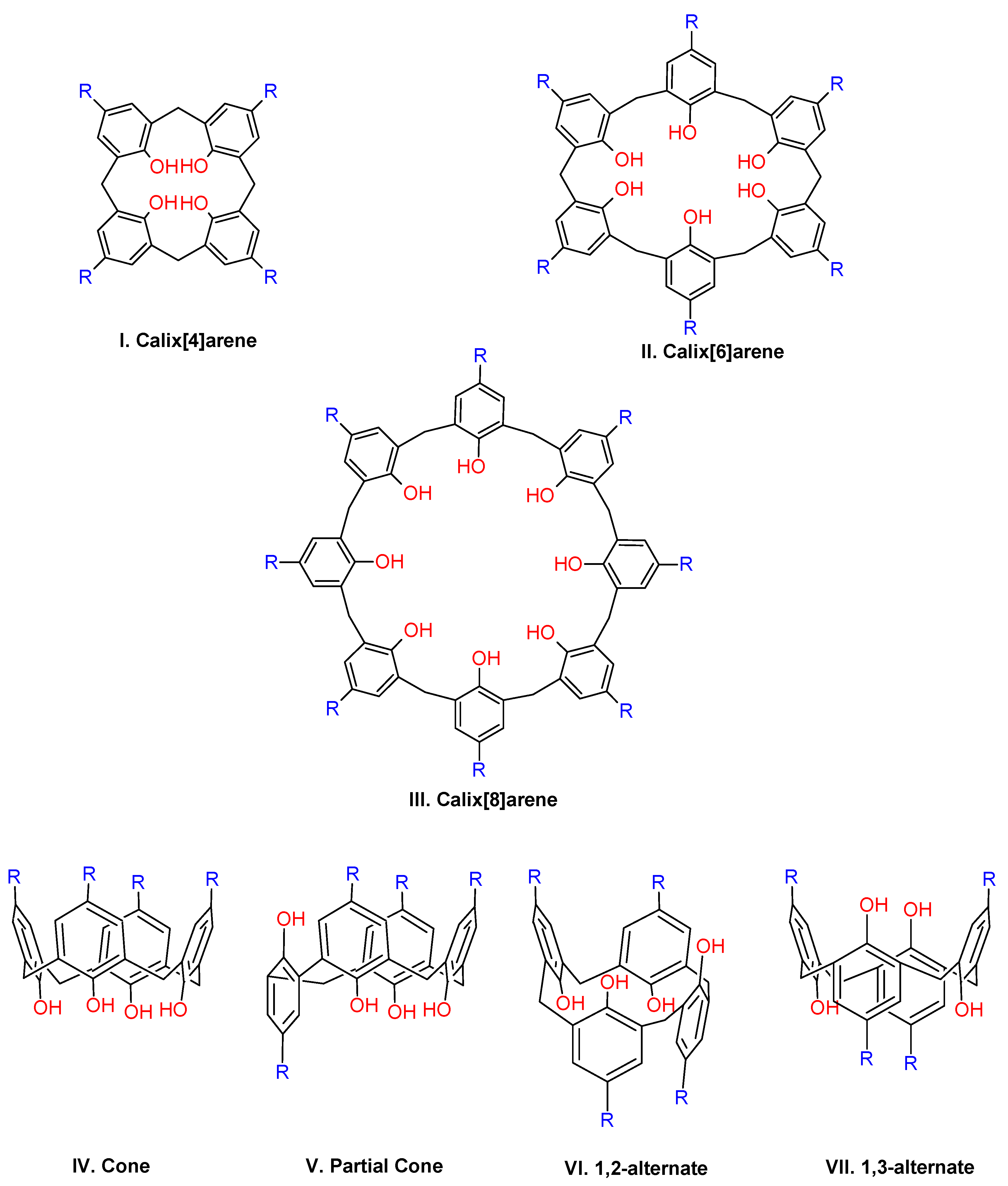
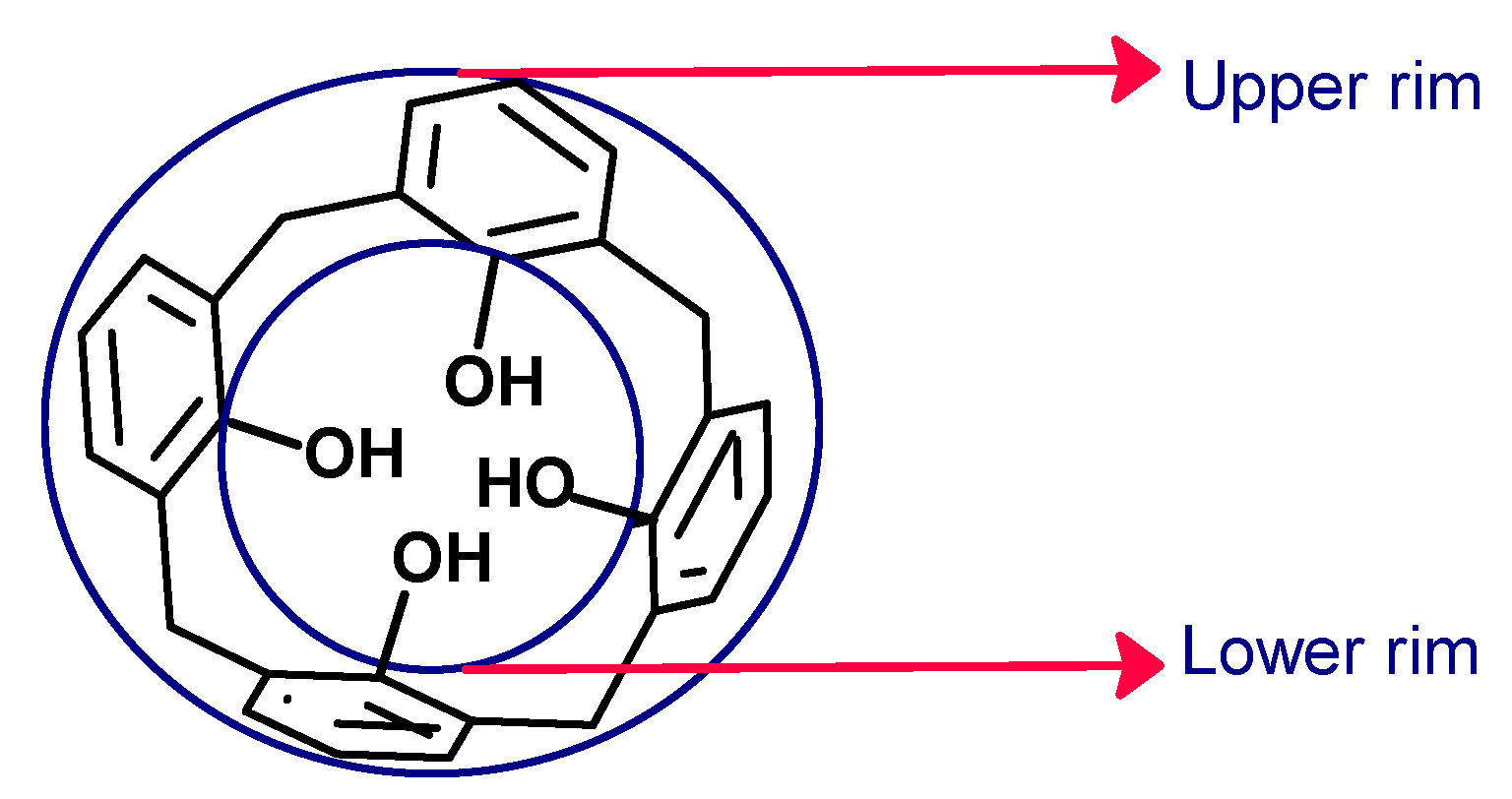

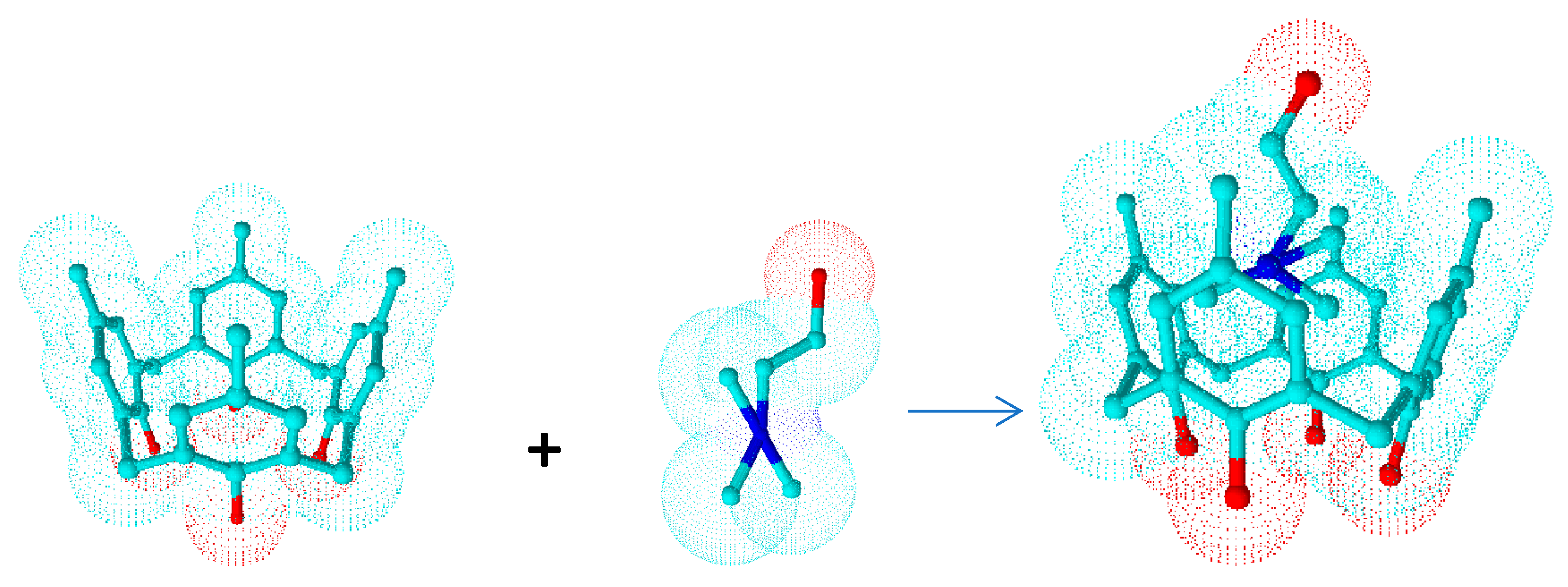
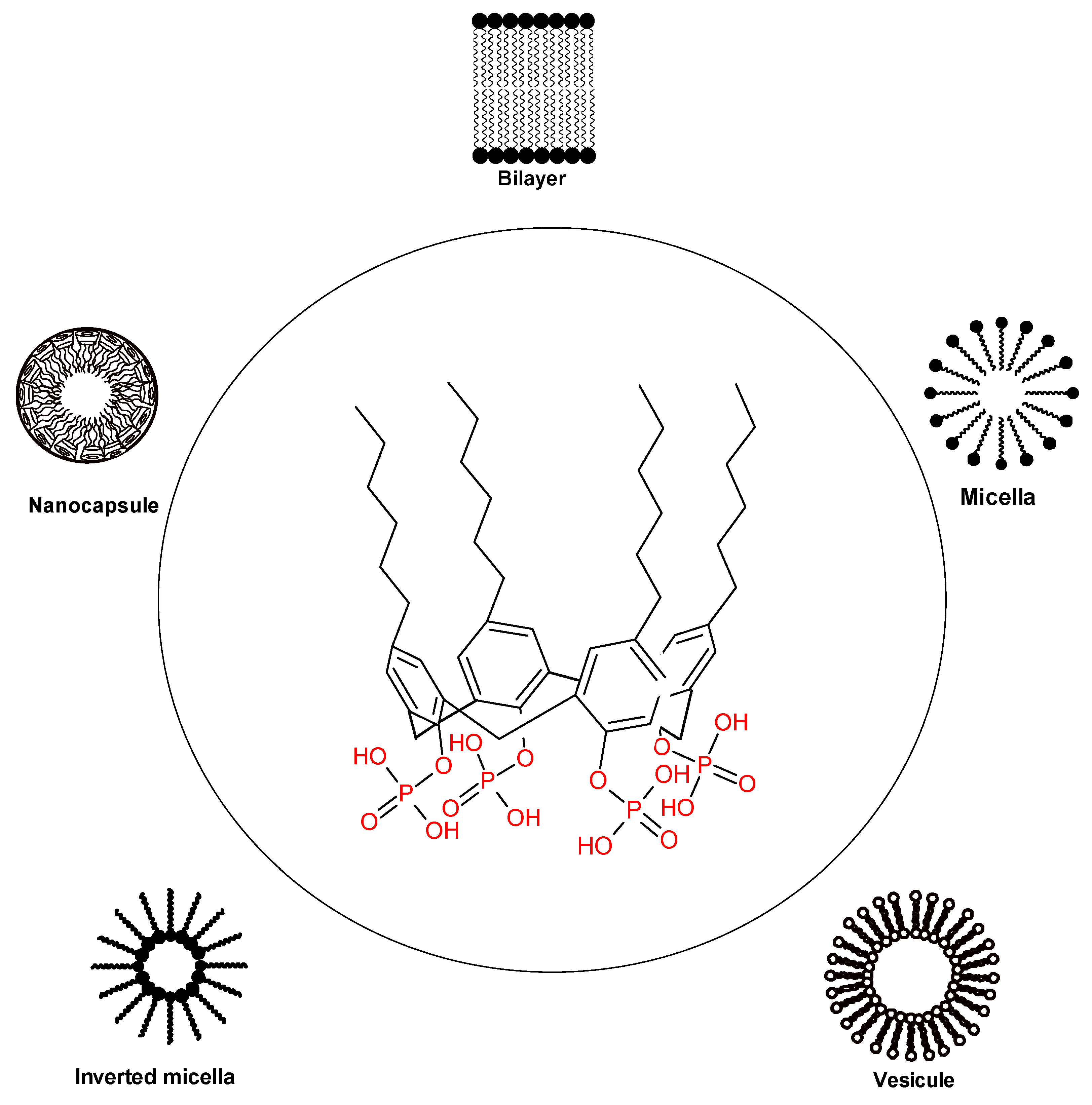
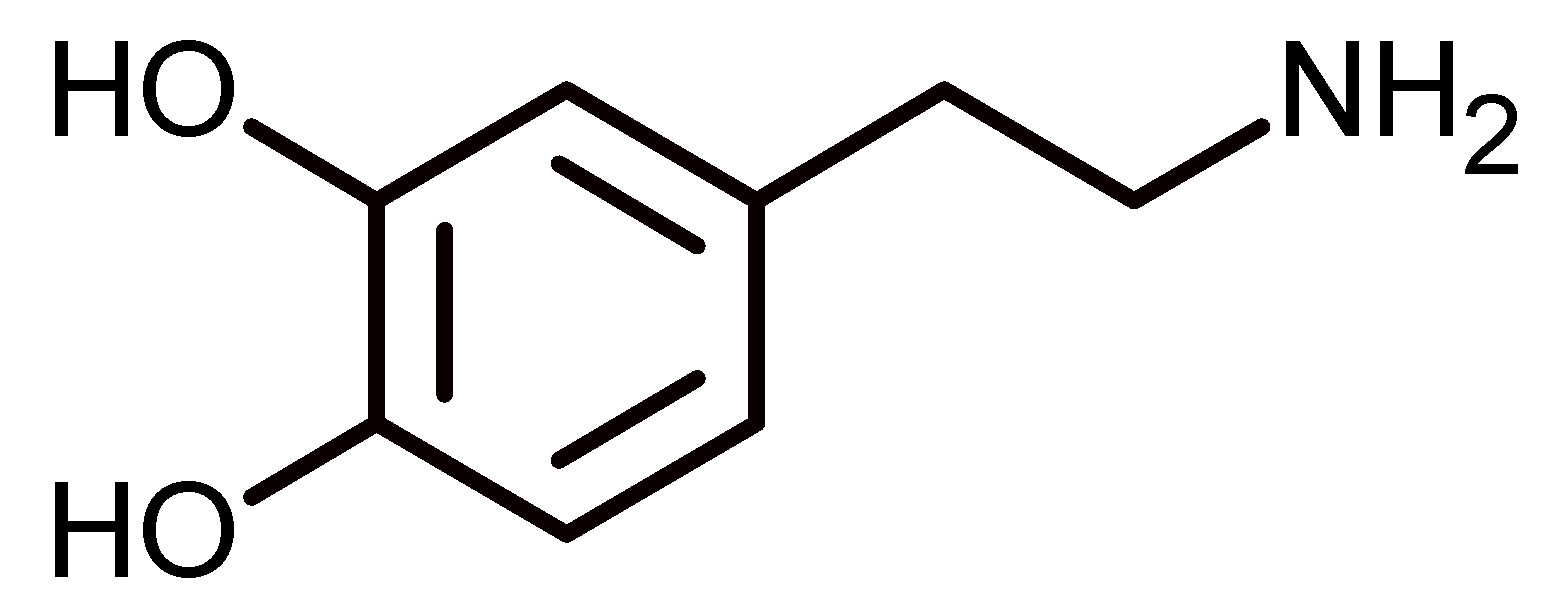
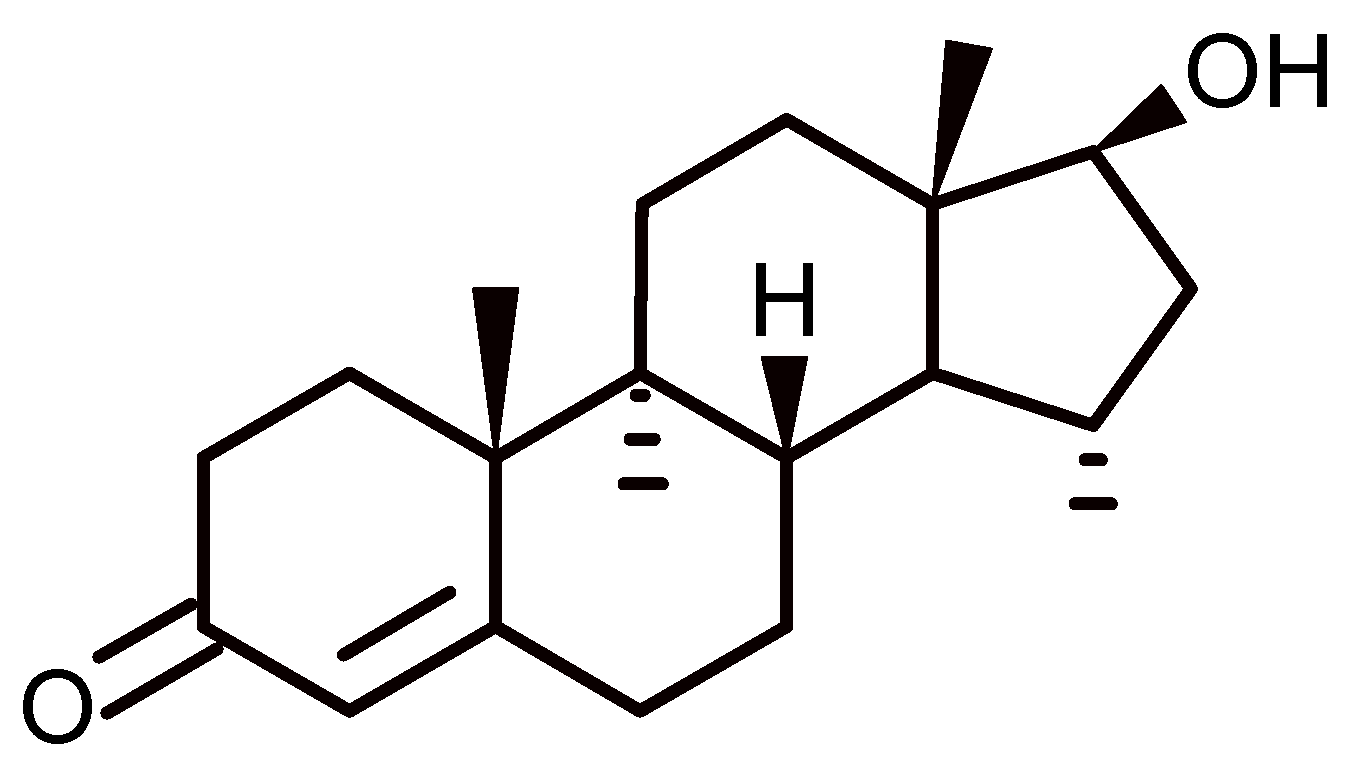
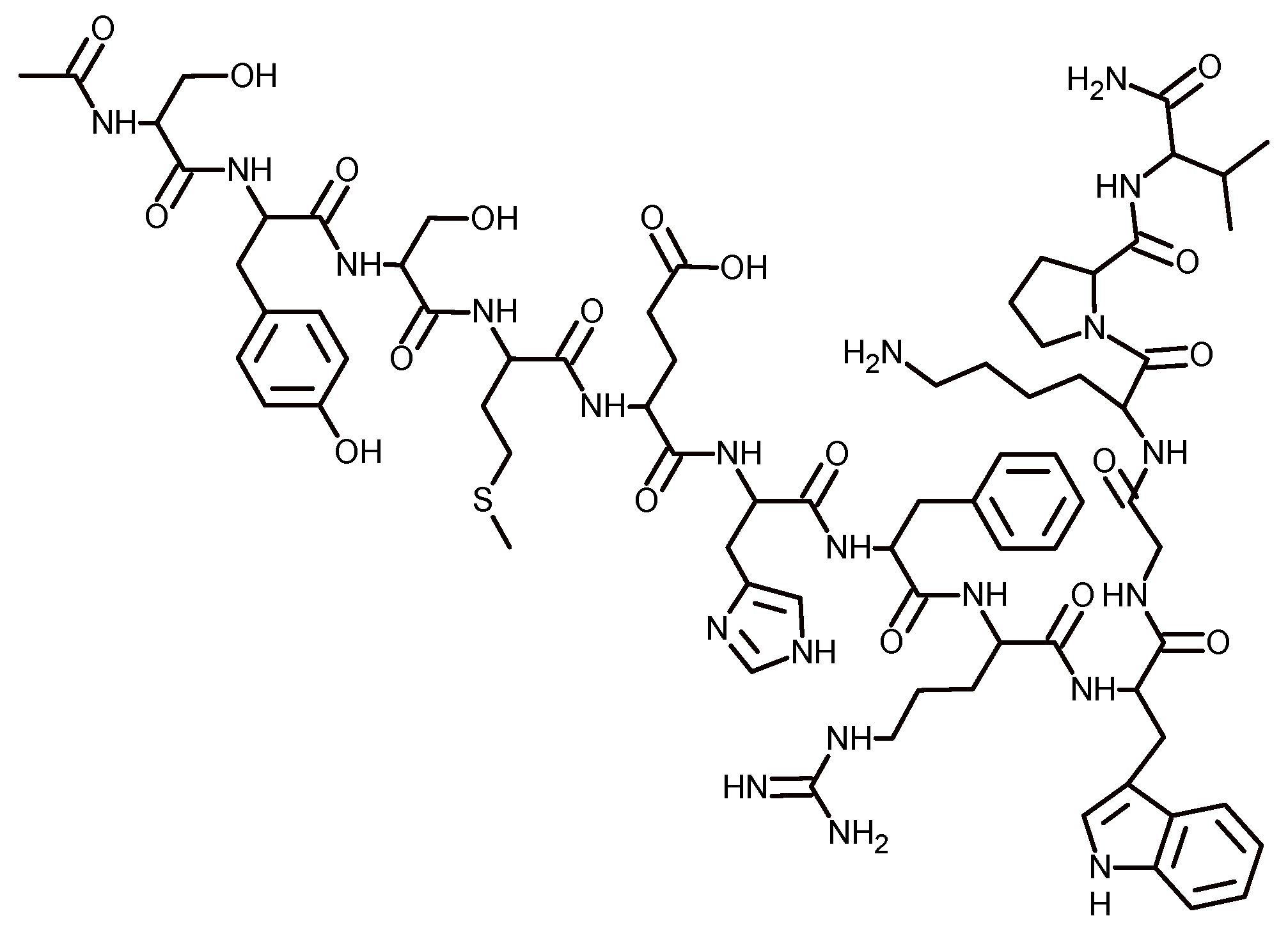
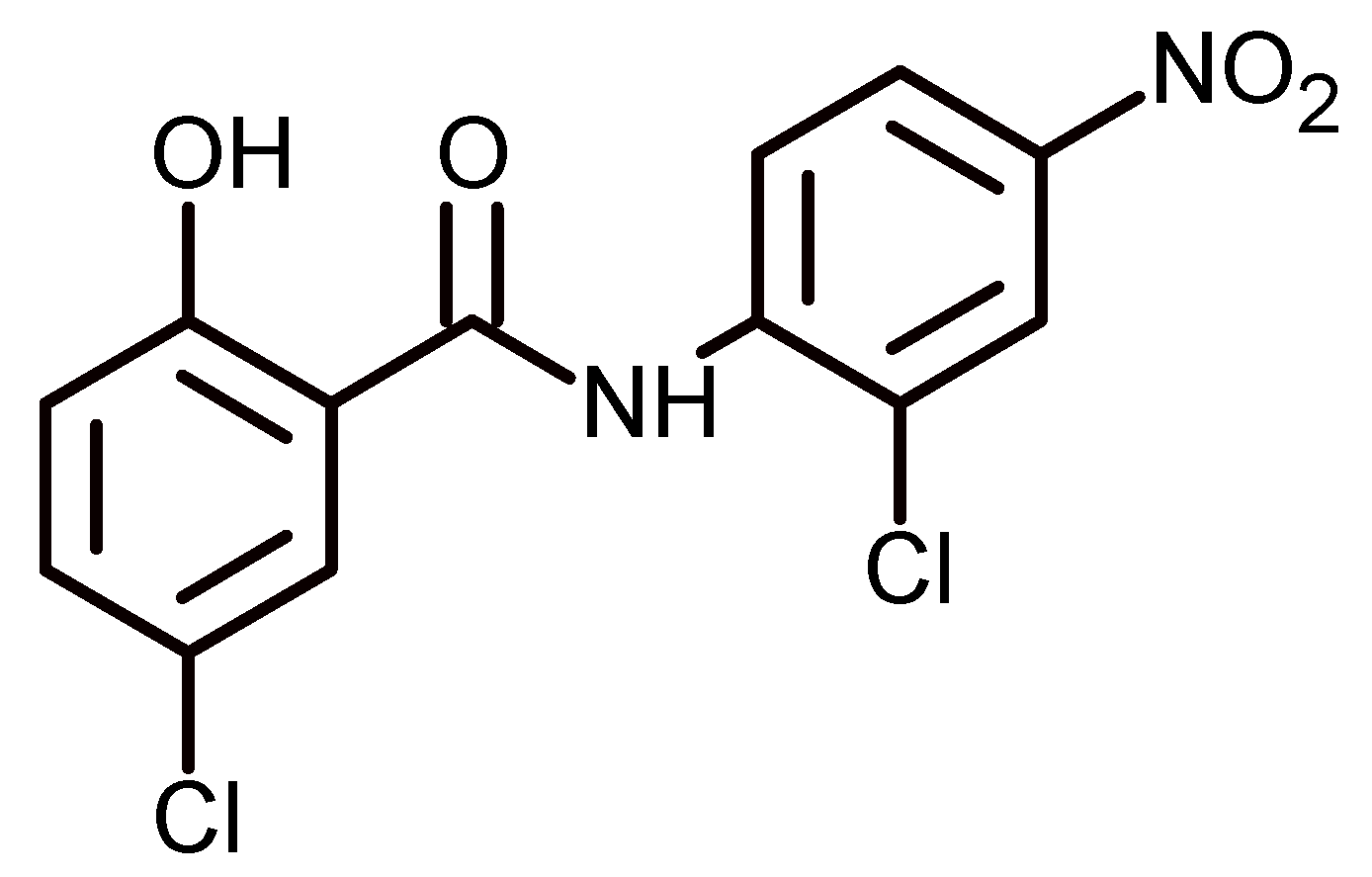
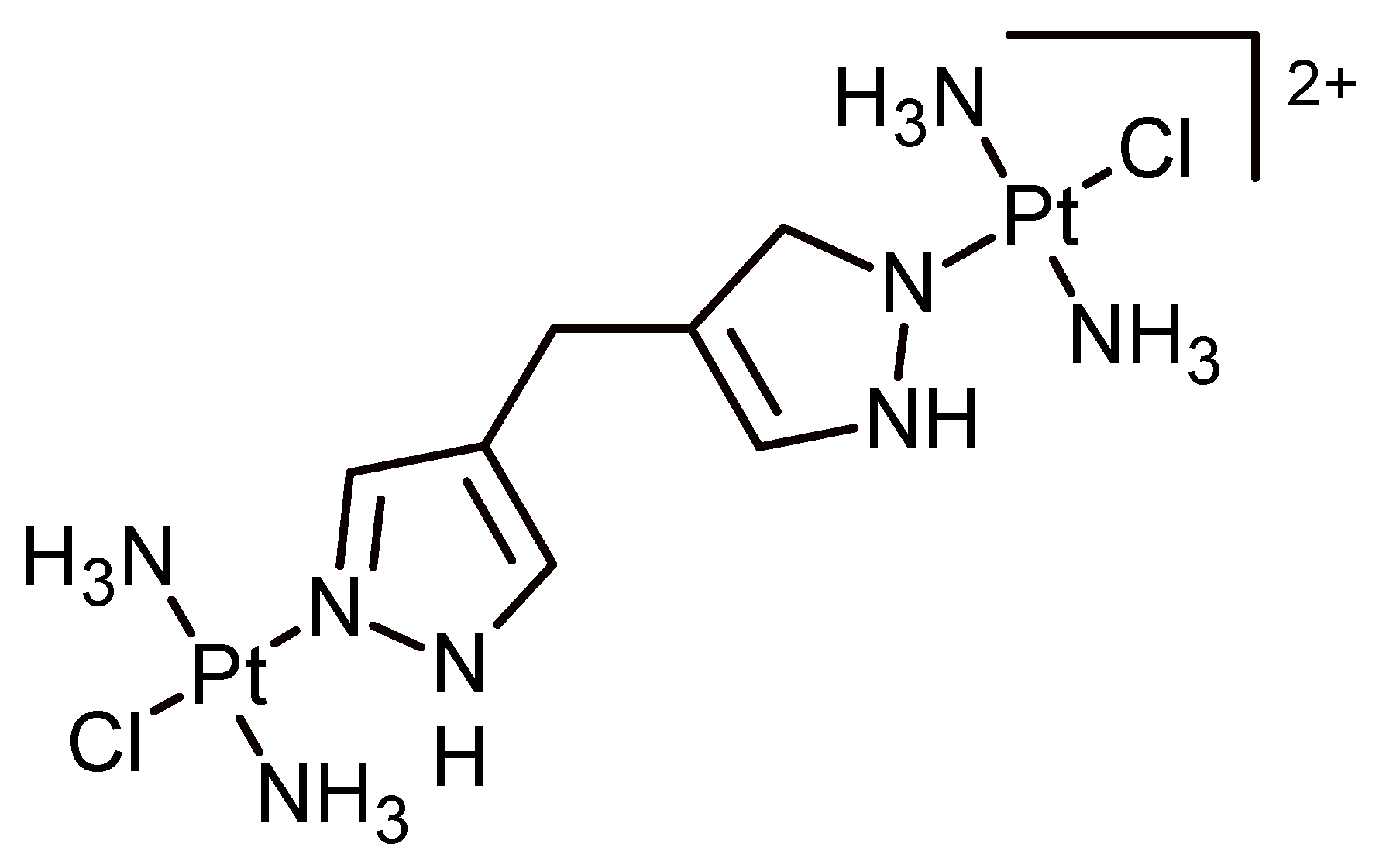
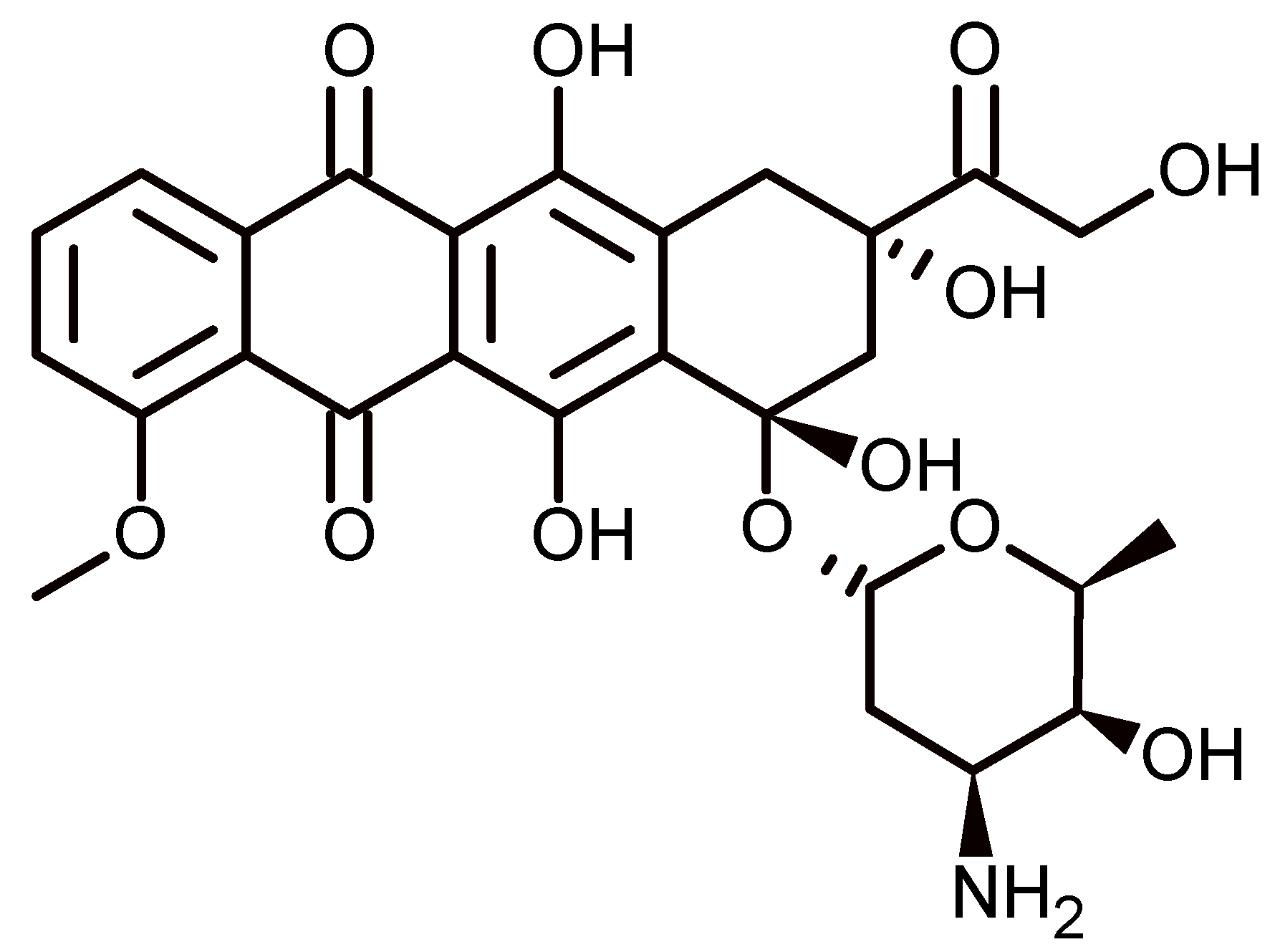
| Molecule of Biological Interest | Calixarenes Used | Method | Conditions | Ref. |
|---|---|---|---|---|
| Dopamine | 4-tert-butylcalix[6]arene | Electrochemical sensing using Langmuir–Blodgett films |
| [62] |
| Testosterone | 4-sulphonic calix[4]arenes, 4-sulphonic calix[6]arenes, 4-sulphonic calix[8]arenes. | The concentration of testosterone was determined by HPLC method | The solubility of samples were measured at 25 °C at pH 5.8, 7.3, and 10 | [63] |
| α-Melanocyte hormone | C-tetra(octyl)calixresorcin [4]arene | The surface was characterized by XPS and MALDI-ToF MS | The peptide was attached to the calixarene with PEG-350 and then coated onto glass | [65] |
| Green fluorescent protein | 5,11,17,23-tetra-tert-butyl-25,26,27,28-tetramethoxycarbonylmethoxy-calix[4]arene | The fiber modified was characterized by FTIR, TGA analysis, UV–Vis, fluorescence microscopy and SEM |
| [67] |
| Niclosamide (anthelmintic drug) | 4-sulphonatocalix[6]arene | The complexation between calixarene-cyclodextrin and niclosamide was followed by thermal analysis. The niclosamide content was determined by HPLC | Solubility studies were done in a pH 7.0 buffer at 30 °C and ionic strength of 0.5 mol/L | [67] |
| Dinuclear platinum complex | p-sulphonatocalix[4]arene | The complex was examined using 1H nuclear magnetic resonance and electrospray ionization mass spectrometry, among others |
| [71] |
| Doxorubicin | p-sulphonatocalix[4]arene | The nanosupramolecular binary vesicles was studied by UV–Vis, fluorescence spectroscopy, dynamic laser scattering, transmission electron microscopy, scanning electron microscopy, and surface tension |
| [70] |
© 2019 by the authors. Licensee MDPI, Basel, Switzerland. This article is an open access article distributed under the terms and conditions of the Creative Commons Attribution (CC BY) license (http://creativecommons.org/licenses/by/4.0/).
Share and Cite
Español, E.S.; Villamil, M.M. Calixarenes: Generalities and Their Role in Improving the Solubility, Biocompatibility, Stability, Bioavailability, Detection, and Transport of Biomolecules. Biomolecules 2019, 9, 90. https://doi.org/10.3390/biom9030090
Español ES, Villamil MM. Calixarenes: Generalities and Their Role in Improving the Solubility, Biocompatibility, Stability, Bioavailability, Detection, and Transport of Biomolecules. Biomolecules. 2019; 9(3):90. https://doi.org/10.3390/biom9030090
Chicago/Turabian StyleEspañol, Edilma Sanabria, and Mauricio Maldonado Villamil. 2019. "Calixarenes: Generalities and Their Role in Improving the Solubility, Biocompatibility, Stability, Bioavailability, Detection, and Transport of Biomolecules" Biomolecules 9, no. 3: 90. https://doi.org/10.3390/biom9030090
APA StyleEspañol, E. S., & Villamil, M. M. (2019). Calixarenes: Generalities and Their Role in Improving the Solubility, Biocompatibility, Stability, Bioavailability, Detection, and Transport of Biomolecules. Biomolecules, 9(3), 90. https://doi.org/10.3390/biom9030090




